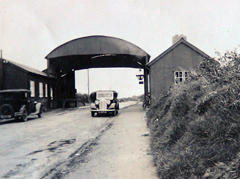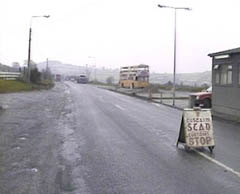Custom points, shops and services

1930s Customs post, Source: Private Collection
The first concrete signs of the existence of the border following partition began to appear three years later in 1923 when arrangements were put in place to establish the fiscal separation of the Irish Free State from the United Kingdom of Great Britain and Northern Ireland. In practice this meant introducing the system of levying duties on certain goods being brought into one jurisdiction from the other. This entailed establishing a system for checking on the movement of goods across the border by requiring people to use approved routes to do so and setting up official points at which customs officers would check what people were bringing with them across the border. See A Changing Border.
These custom points, stations, or posts, as they were known, which often took the form of small, one or two roomed huts, became established features of the border landscape, just as being subject to custom checks became an established part of borderlands life for decades. See Borderland lives.
Since the customs barrier was integral to the new political partition of the island, custom posts were frequently the target of Republican bombing attacks especially during the Troubles. They were finally made redundant in 1992 when free trade was established within the European Union. As member states, movement of goods between the Republic of Ireland and the United Kingdom of Great Britain and Northern Ireland, can no longer be subject to import duties. Some custom huts no longer exist. Some are converted to other uses. Others stand unused as reminders of a once dominant feature of the border and borderland life.
Differences in the price or availability of goods on either side of the border also led to a pattern of shops just over the border on either side. Though what people travelled to buy and bring back across the border could be subject to duties that people tried to evade, small shops, selling butter or eggs for example, were often established in response to this market opportunity.

Irish customs post sign on Newry-Dundalk road. Source: UTV Newsfootage, 14 February 1984.
As car transport increased over the twentieth century, approved routes often featured petrol stations offering cheaper prices just over the border; which side of the border they were on depended on changing price differences. Many closed as the patterns of advantage shifted and disused filling stations are a feature of border crossing routes.
The use of the euro in the Republic and the British pound sterling in Northern Ireland means that main roads also feature roadside currency exchanges offering motorists opportunities to buy euros or pounds sterling near the border. The changing role of the border as barrier between two state economies is reflected in the disused or new structures – custom huts, filling stations, shops – that feature near the border on the old approved crossing routes.
